LabVIEWTM
Advanced Signal Processing Toolkit
Time Frequency Analysis Tools User Manual
Time Frequency Analysis Tools User Manual
June 2008
371552B-01
�
Support
Worldwide Technical Support and Product Information
ni.com
National Instruments Corporate Headquarters
11500 North Mopac Expressway Austin, Texas 78759-3504 USA Tel: 512 683 0100
Worldwide Offices
Australia 1800 300 800, Austria 43 662 457990-0, Belgium 32 (0) 2 757 0020, Brazil 55 11 3262 3599,
Canada 800 433 3488, China 86 21 5050 9800, Czech Republic 420 224 235 774, Denmark 45 45 76 26 00,
Finland 358 (0) 9 725 72511, France 01 57 66 24 24, Germany 49 89 7413130, India 91 80 41190000,
Israel 972 3 6393737, Italy 39 02 41309277, Japan 0120-527196, Korea 82 02 3451 3400,
Lebanon 961 (0) 1 33 28 28, Malaysia 1800 887710, Mexico 01 800 010 0793, Netherlands 31 (0) 348 433 466,
New Zealand 0800 553 322, Norway 47 (0) 66 90 76 60, Poland 48 22 3390150, Portugal 351 210 311 210,
Russia 7 495 783 6851, Singapore 1800 226 5886, Slovenia 386 3 425 42 00, South Africa 27 0 11 805 8197,
Spain 34 91 640 0085, Sweden 46 (0) 8 587 895 00, Switzerland 41 56 2005151, Taiwan 886 02 2377 2222,
Thailand 662 278 6777, Turkey 90 212 279 3031, United Kingdom 44 (0) 1635 523545
For further support information, refer to the Technical Support and Professional Services appendix. To comment
on National Instruments documentation, refer to the National Instruments Web site at ni.com/info and enter
the info code feedback.
© 2005–2008 National Instruments Corporation. All rights reserved.
�
Important Information
Warranty
The media on which you receive National Instruments software are warranted not to fail to execute programming instructions, due to defects
in materials and workmanship, for a period of 90 days from date of shipment, as evidenced by receipts or other documentation. National
Instruments will, at its option, repair or replace software media that do not execute programming instructions if National Instruments receives
notice of such defects during the warranty period. National Instruments does not warrant that the operation of the software shall be
uninterrupted or error free.
A Return Material Authorization (RMA) number must be obtained from the factory and clearly marked on the outside of the package before any
equipment will be accepted for warranty work. National Instruments will pay the shipping costs of returning to the owner parts which are covered by
warranty.
National Instruments believes that the information in this document is accurate. The document has been carefully reviewed for technical accuracy. In
the event that technical or typographical errors exist, National Instruments reserves the right to make changes to subsequent editions of this document
without prior notice to holders of this edition. The reader should consult National Instruments if errors are suspected. In no event shall National
Instruments be liable for any damages arising out of or related to this document or the information contained in it.
EXCEPT AS SPECIFIED HEREIN, NATIONAL INSTRUMENTS MAKES NO WARRANTIES, EXPRESS OR IMPLIED, AND SPECIFICALLY DISCLAIMS ANY WARRANTY OF
MERCHANTABILITY OR FITNESS FOR A PARTICULAR PURPOSE. CUSTOMER’S RIGHT TO RECOVER DAMAGES CAUSED BY FAULT OR NEGLIGENCE ON THE PART OF NATIONAL
INSTRUMENTS SHALL BE LIMITED TO THE AMOUNT THERETOFORE PAID BY THE CUSTOMER. NATIONAL INSTRUMENTS WILL NOT BE LIABLE FOR DAMAGES RESULTING
FROM LOSS OF DATA, PROFITS, USE OF PRODUCTS, OR INCIDENTAL OR CONSEQUENTIAL DAMAGES, EVEN IF ADVISED OF THE POSSIBILITY THEREOF. This limitation of
the liability of National Instruments will apply regardless of the form of action, whether in contract or tort, including negligence. Any action against
National Instruments must be brought within one year after the cause of action accrues. National Instruments shall not be liable for any delay in
performance due to causes beyond its reasonable control. The warranty provided herein does not cover damages, defects, malfunctions, or service
failures caused by owner’s failure to follow the National Instruments installation, operation, or maintenance instructions; owner’s modification of the
product; owner’s abuse, misuse, or negligent acts; and power failure or surges, fire, flood, accident, actions of third parties, or other events outside
reasonable control.
Copyright
Under the copyright laws, this publication may not be reproduced or transmitted in any form, electronic or mechanical, including photocopying,
recording, storing in an information retrieval system, or translating, in whole or in part, without the prior written consent of National
Instruments Corporation.
National Instruments respects the intellectual property of others, and we ask our users to do the same. NI software is protected by copyright and other
intellectual property laws. Where NI software may be used to reproduce software or other materials belonging to others, you may use NI software only
to reproduce materials that you may reproduce in accordance with the terms of any applicable license or other legal restriction.
Trademarks
National Instruments, NI, ni.com, and LabVIEW are trademarks of National Instruments Corporation. Refer to the Terms of Use section
on ni.com/legal for more information about National Instruments trademarks.
Other product and company names mentioned herein are trademarks or trade names of their respective companies.
Members of the National Instruments Alliance Partner Program are business entities independent from National Instruments and have no agency,
partnership, or joint-venture relationship with National Instruments.
Patents
For patents covering National Instruments products, refer to the appropriate location: Help»Patents in your software, the patents.txt file
on your media, or ni.com/patents.
WARNING REGARDING USE OF NATIONAL INSTRUMENTS PRODUCTS
(1) NATIONAL INSTRUMENTS PRODUCTS ARE NOT DESIGNED WITH COMPONENTS AND TESTING FOR A LEVEL OF
RELIABILITY SUITABLE FOR USE IN OR IN CONNECTION WITH SURGICAL IMPLANTS OR AS CRITICAL COMPONENTS IN
ANY LIFE SUPPORT SYSTEMS WHOSE FAILURE TO PERFORM CAN REASONABLY BE EXPECTED TO CAUSE SIGNIFICANT
INJURY TO A HUMAN.
(2) IN ANY APPLICATION, INCLUDING THE ABOVE, RELIABILITY OF OPERATION OF THE SOFTWARE PRODUCTS CAN BE
IMPAIRED BY ADVERSE FACTORS, INCLUDING BUT NOT LIMITED TO FLUCTUATIONS IN ELECTRICAL POWER SUPPLY,
COMPUTER HARDWARE MALFUNCTIONS, COMPUTER OPERATING SYSTEM SOFTWARE FITNESS, FITNESS OF COMPILERS
AND DEVELOPMENT SOFTWARE USED TO DEVELOP AN APPLICATION, INSTALLATION ERRORS, SOFTWARE AND HARDWARE
COMPATIBILITY PROBLEMS, MALFUNCTIONS OR FAILURES OF ELECTRONIC MONITORING OR CONTROL DEVICES,
TRANSIENT FAILURES OF ELECTRONIC SYSTEMS (HARDWARE AND/OR SOFTWARE), UNANTICIPATED USES OR MISUSES, OR
ERRORS ON THE PART OF THE USER OR APPLICATIONS DESIGNER (ADVERSE FACTORS SUCH AS THESE ARE HEREAFTER
COLLECTIVELY TERMED “SYSTEM FAILURES”). ANY APPLICATION WHERE A SYSTEM FAILURE WOULD CREATE A RISK OF
HARM TO PROPERTY OR PERSONS (INCLUDING THE RISK OF BODILY INJURY AND DEATH) SHOULD NOT BE RELIANT SOLELY
UPON ONE FORM OF ELECTRONIC SYSTEM DUE TO THE RISK OF SYSTEM FAILURE. TO AVOID DAMAGE, INJURY, OR DEATH,
THE USER OR APPLICATION DESIGNER MUST TAKE REASONABLY PRUDENT STEPS TO PROTECT AGAINST SYSTEM FAILURES,
INCLUDING BUT NOT LIMITED TO BACK-UP OR SHUT DOWN MECHANISMS. BECAUSE EACH END-USER SYSTEM IS
CUSTOMIZED AND DIFFERS FROM NATIONAL INSTRUMENTS' TESTING PLATFORMS AND BECAUSE A USER OR APPLICATION
DESIGNER MAY USE NATIONAL INSTRUMENTS PRODUCTS IN COMBINATION WITH OTHER PRODUCTS IN A MANNER NOT
EVALUATED OR CONTEMPLATED BY NATIONAL INSTRUMENTS, THE USER OR APPLICATION DESIGNER IS ULTIMATELY
RESPONSIBLE FOR VERIFYING AND VALIDATING THE SUITABILITY OF NATIONAL INSTRUMENTS PRODUCTS WHENEVER
NATIONAL INSTRUMENTS PRODUCTS ARE INCORPORATED IN A SYSTEM OR APPLICATION, INCLUDING, WITHOUT
LIMITATION, THE APPROPRIATE DESIGN, PROCESS AND SAFETY LEVEL OF SUCH SYSTEM OR APPLICATION.
�
Contents
About This Manual
Conventions ...................................................................................................................ix
Related Documentation..................................................................................................x
Chapter 1
Introduction to Time-Frequency Analysis
Common Time-Frequency Analysis Applications ........................................................1-4
Overview of Time Frequency Analysis Tools...............................................................1-5
Finding Example VIs.......................................................................................1-6
Related Signal Processing Tools....................................................................................1-6
Chapter 2
Understanding Linear Time-Frequency Analysis Methods
Short-Time Fourier Transform ......................................................................................2-2
Window Type and Window Length ................................................................2-3
Discrete Gabor Transform and Expansion.....................................................................2-4
Adaptive Transform and Expansion ..............................................................................2-7
Comparing Linear Time-Frequency Analysis Methods ................................................2-13
Chapter 3
Understanding Quadratic Time-Frequency Analysis Methods
STFT Spectrogram.........................................................................................................3-2
Reassignment Method .....................................................................................3-6
Wigner-Ville Distribution..............................................................................................3-7
Other Cohen’s Class Time-Frequency Distributions.....................................................3-10
Choi-Williams Distribution .............................................................................3-11
Cone-Shaped Distribution ...............................................................................3-13
Gabor Spectrogram ........................................................................................................3-14
Adaptive Spectrogram ...................................................................................................3-20
Spectrogram Feature Extraction ....................................................................................3-22
Mean Instantaneous Frequency .......................................................................3-23
Mean Instantaneous Bandwidth ......................................................................3-23
Group Delay ....................................................................................................3-23
Marginal Integration........................................................................................3-24
Creating Quadratic Time-Frequency Analysis Applications.........................................3-24
Comparing Quadratic Time-Frequency Analysis Methods ...........................................3-25
Calculating the Energy of a Signal at Each Time-Frequency Instant............................3-27
© National Instruments Corporation
v
Time Frequency Analysis Tools User Manual
�
Contents
Appendix A
Technical Support and Professional Services
Time Frequency Analysis Tools User Manual
vi
ni.com
�
About This Manual
This manual contains a brief introduction to time-frequency analysis,
includes information about linear and quadratic methods of time-frequency
analysis, and describes how to develop typical applications by using the
LabVIEW Time Frequency Analysis Tools.
This manual requires that you have a basic understanding of the LabVIEW
environment. If you are unfamiliar with LabVIEW, refer to the Getting
Started with LabVIEW manual before reading this manual.
Note This manual is not intended to provide a comprehensive discussion of
time-frequency analysis. Refer to Introduction to Time-Frequency and Wavelet
Transforms1 for more information about time-frequency analysis.
Conventions
»
bold
italic
monospace
The following conventions appear in this manual:
The » symbol leads you through nested menu items and dialog box options
to a final action. The sequence File»Page Setup»Options directs you to
pull down the File menu, select the Page Setup item, and select Options
from the last dialog box.
This icon denotes a note, which alerts you to important information.
Bold text denotes items that you must select or click in the software, such
as menu items and dialog box options. Bold text also denotes parameter
names.
Italic text denotes variables, emphasis, a cross-reference, or an introduction
to a key concept. Italic text also denotes text that is a placeholder for a word
or value that you must supply.
Text in this font denotes text or characters that you should enter from the
keyboard, sections of code, programming examples, and syntax examples.
This font is also used for the proper names of disk drives, paths, directories,
programs, subprograms, subroutines, device names, functions, operations,
variables, filenames, and extensions.
1 Qian, Shie. Introduction to Time-Frequency and Wavelet Transforms. Upper Saddle River, New Jersey: Prentice Hall PTR,
2001.
© National Instruments Corporation
ix
Time Frequency Analysis Tools User Manual
�
About This Manual
Related Documentation
The following documents contain information that you may find helpful as
you read this manual:
•
LabVIEW Help, available by selecting Help»Search the LabVIEW
Help
Getting Started with LabVIEW, available by selecting Start»
All Programs»National Instruments»LabVIEW x.x»
LabVIEW Manuals, where x.x is the version of LabVIEW you
installed, and opening LV_Getting_Started.pdf. This manual also
is available by navigating to the labview\manuals directory and
opening LV_Getting_Started.pdf. The LabVIEW Help includes
all the content in this manual.
LabVIEW Fundamentals, available by selecting Start»All Programs»
National Instruments»LabVIEW x.x»LabVIEW Manuals, where
x.x is the version of LabVIEW you installed, and opening
LV_Fundamentals.pdf. This manual also is available by navigating
to the labview\manuals directory and opening
LV_Fundamentals.pdf. The LabVIEW Help includes all the content
in this manual.
Note The following resource offers useful background information on the general
concepts discussed in this documentation. This resource is provided for general
informational purposes only and is not affiliated, sponsored, or endorsed by National
Instruments. The content of this resource is not a representation of, may not correspond to,
and does not imply current or future functionality in the Time Series Analysis Tools or any
other National Instruments product.
Qian, Shie. Introduction to Time-Frequency and Wavelet Transforms.
Upper Saddle River, New Jersey: Prentice Hall PTR, 2001.
Time Frequency Analysis Tools User Manual
x
ni.com
�
Introduction to Time-Frequency
Analysis
1
One way to represent a signal is the time-domain waveform, which shows
how the amplitude of the signal changes over time. Examples of
time-varying signals include the temperature in temperature logs,
stock-index profiles, electrocardiogram signals, vibration signals, and
speech signals, such as the speech signal in Figure 1-1.
Figure 1-1. Speech Signal
The time-domain speech waveform in Figure 1-1 depicts how the
sound-pressure level evolves over time. The higher the sound-pressure level
at any particular time, the larger the magnitude, or the absolute value, of the
signal.
An important task in most speech-enhancement applications is to find the
noise characteristics and then remove the noise from the speech signal. In
Figure 1-1, the period from 1.4 s to 2.0 s is the silence period, when no
speech is present. Any signal measured during this time frame is noise. In
speech-enhancement applications, you often observe the signal during the
silence periods to estimate the noise characteristics.
© National Instruments Corporation
1-1
Time Frequency Analysis Tools User Manual
�
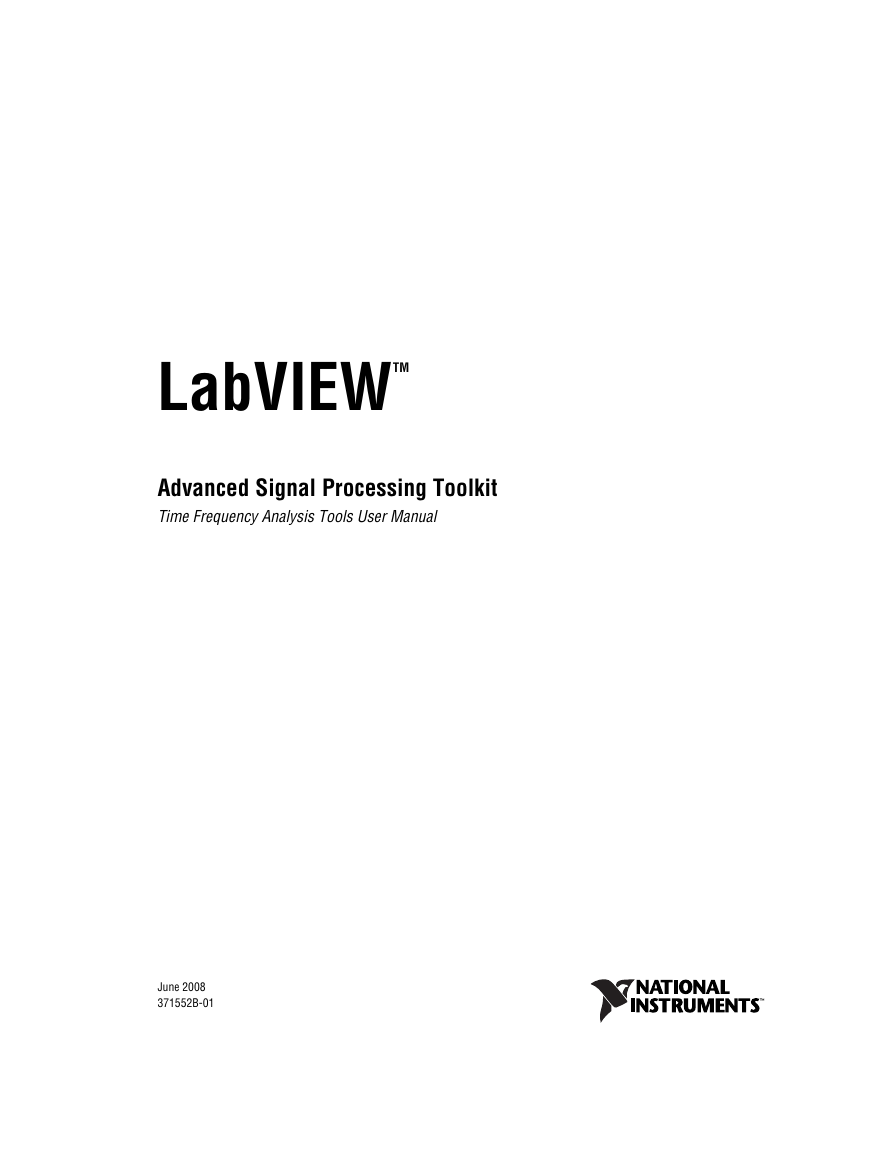

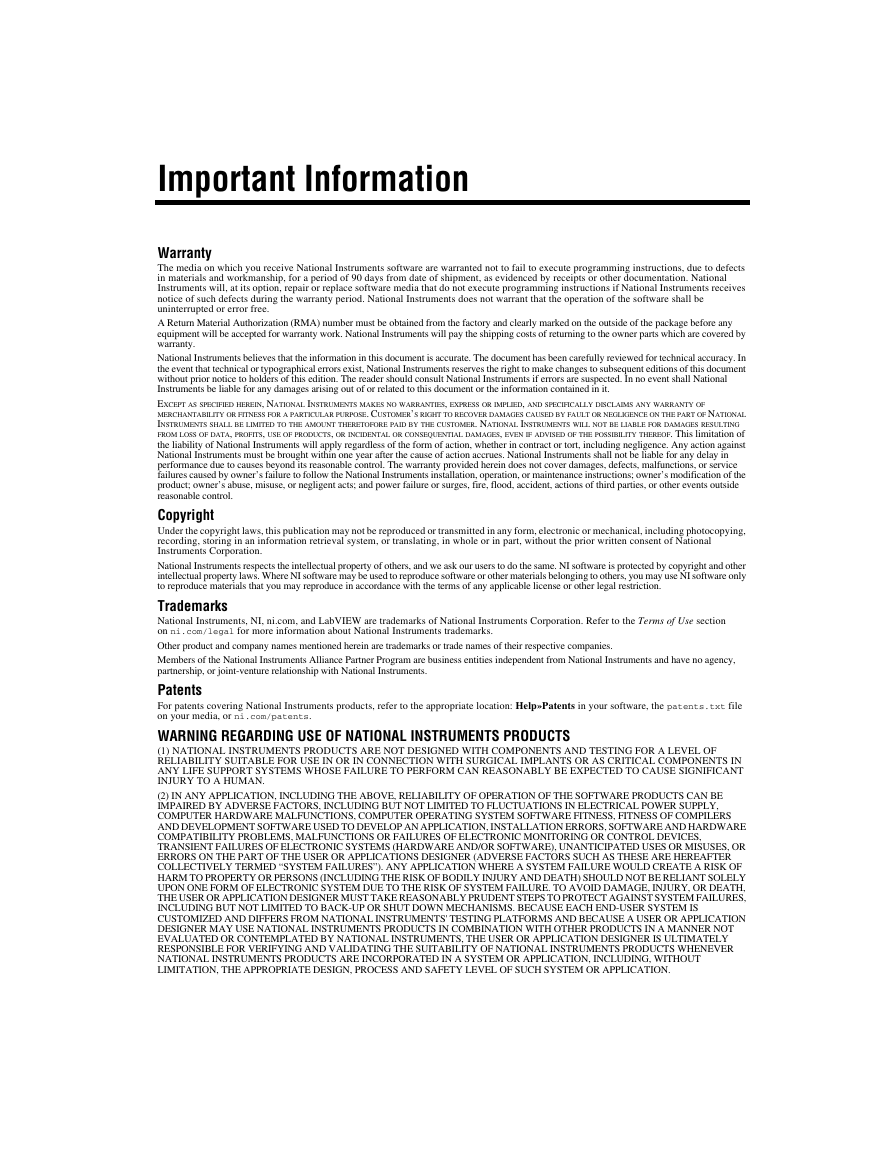
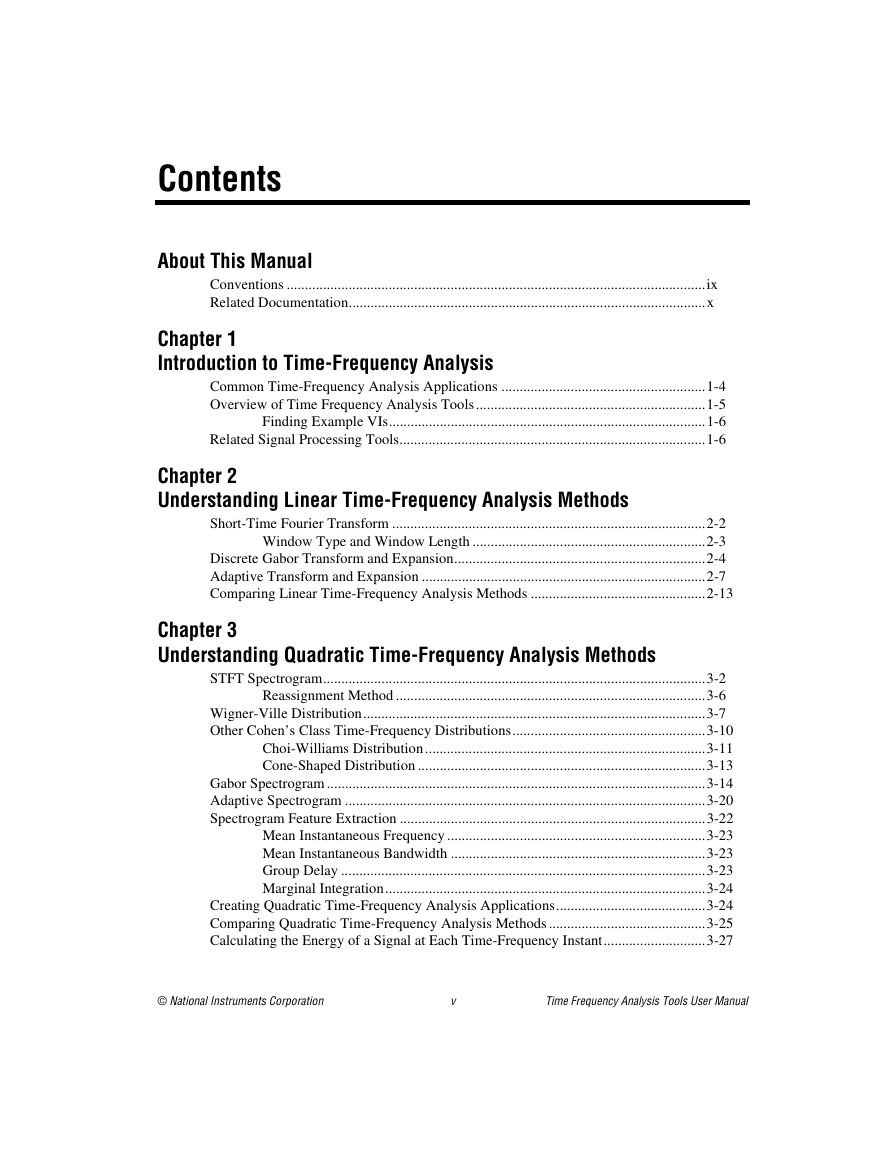
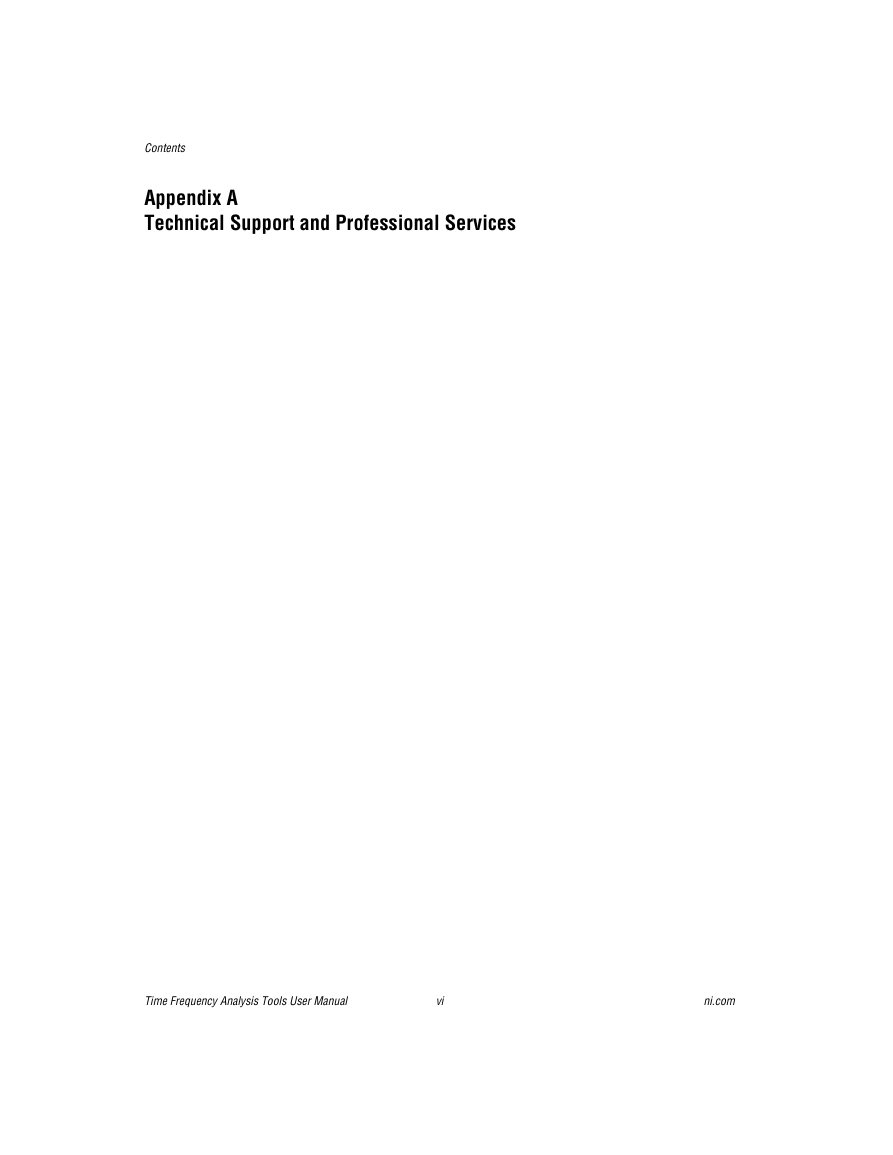

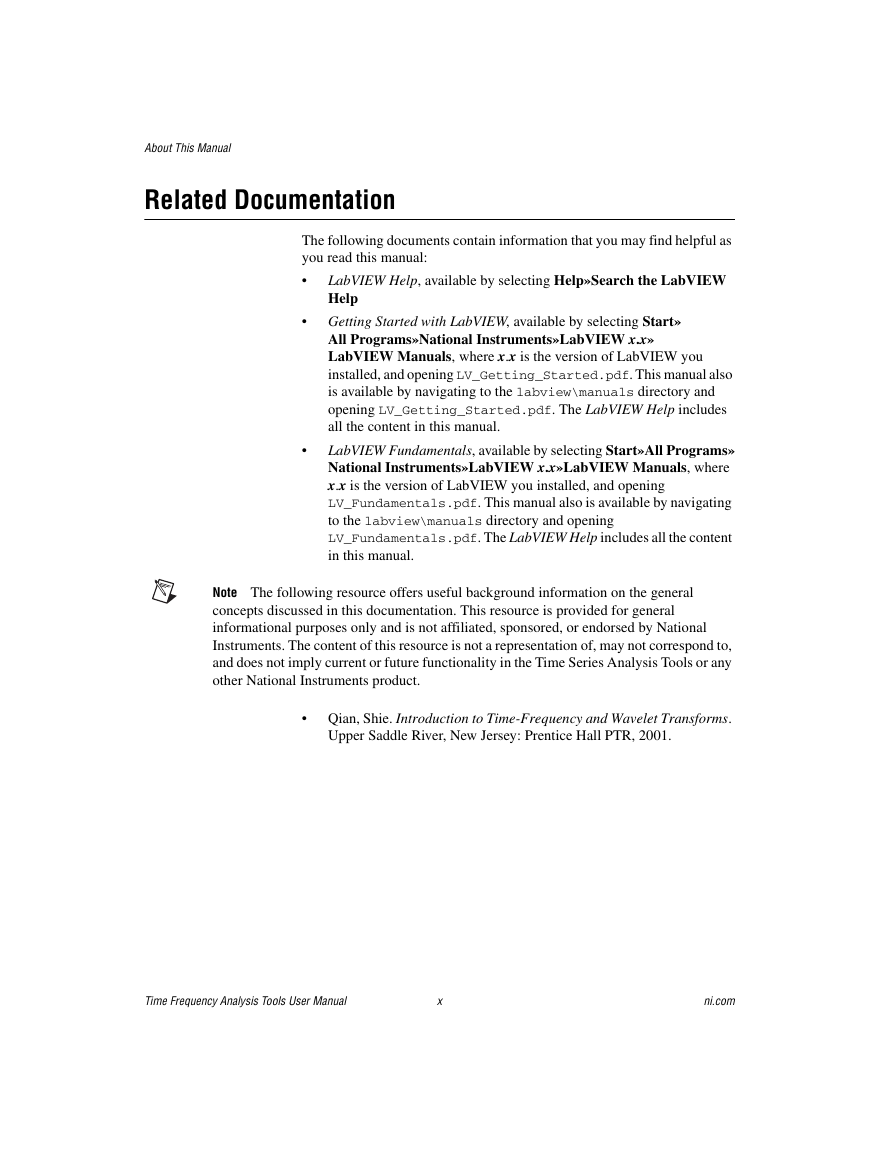









 2023年江西萍乡中考道德与法治真题及答案.doc
2023年江西萍乡中考道德与法治真题及答案.doc 2012年重庆南川中考生物真题及答案.doc
2012年重庆南川中考生物真题及答案.doc 2013年江西师范大学地理学综合及文艺理论基础考研真题.doc
2013年江西师范大学地理学综合及文艺理论基础考研真题.doc 2020年四川甘孜小升初语文真题及答案I卷.doc
2020年四川甘孜小升初语文真题及答案I卷.doc 2020年注册岩土工程师专业基础考试真题及答案.doc
2020年注册岩土工程师专业基础考试真题及答案.doc 2023-2024学年福建省厦门市九年级上学期数学月考试题及答案.doc
2023-2024学年福建省厦门市九年级上学期数学月考试题及答案.doc 2021-2022学年辽宁省沈阳市大东区九年级上学期语文期末试题及答案.doc
2021-2022学年辽宁省沈阳市大东区九年级上学期语文期末试题及答案.doc 2022-2023学年北京东城区初三第一学期物理期末试卷及答案.doc
2022-2023学年北京东城区初三第一学期物理期末试卷及答案.doc 2018上半年江西教师资格初中地理学科知识与教学能力真题及答案.doc
2018上半年江西教师资格初中地理学科知识与教学能力真题及答案.doc 2012年河北国家公务员申论考试真题及答案-省级.doc
2012年河北国家公务员申论考试真题及答案-省级.doc 2020-2021学年江苏省扬州市江都区邵樊片九年级上学期数学第一次质量检测试题及答案.doc
2020-2021学年江苏省扬州市江都区邵樊片九年级上学期数学第一次质量检测试题及答案.doc 2022下半年黑龙江教师资格证中学综合素质真题及答案.doc
2022下半年黑龙江教师资格证中学综合素质真题及答案.doc